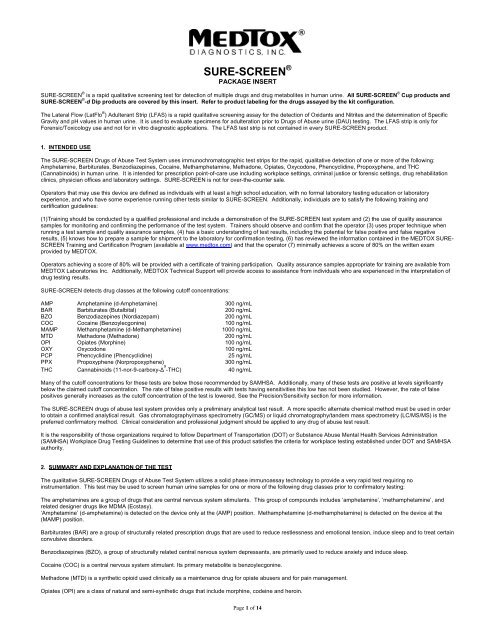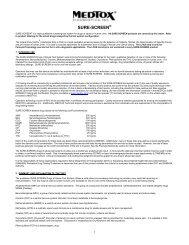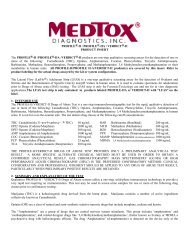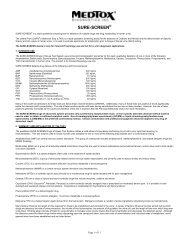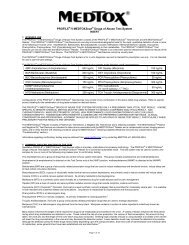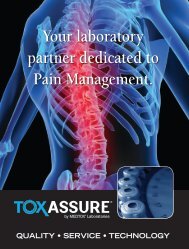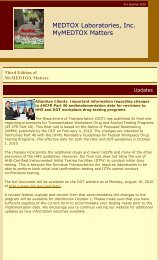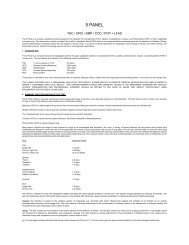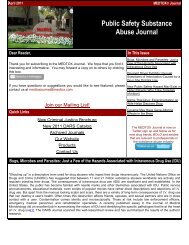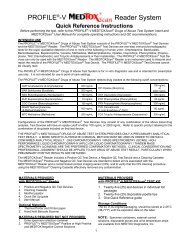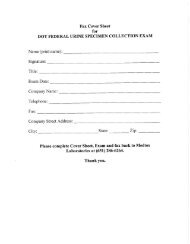Package Insert Rev. 4/10a - MedTox
Package Insert Rev. 4/10a - MedTox
Package Insert Rev. 4/10a - MedTox
- No tags were found...
Create successful ePaper yourself
Turn your PDF publications into a flip-book with our unique Google optimized e-Paper software.
SURE-SCREEN ®PACKAGE INSERTSURE-SCREEN ® is a rapid qualitative screening test for detection of multiple drugs and drug metabolites in human urine. All SURE-SCREEN ® Cup products andSURE-SCREEN ® -d Dip products are covered by this insert. Refer to product labeling for the drugs assayed by the kit configuration.The Lateral Flow (LatFlo ® ) Adulterant Strip (LFAS) is a rapid qualitative screening assay for the detection of Oxidants and Nitrites and the determination of SpecificGravity and pH values in human urine. It is used to evaluate specimens for adulteration prior to Drugs of Abuse urine (DAU) testing. The LFAS strip is only forForensic/Toxicology use and not for in vitro diagnostic applications. The LFAS test strip is not contained in every SURE-SCREEN product.1. INTENDED USEThe SURE-SCREEN Drugs of Abuse Test System uses immunochromatographic test strips for the rapid, qualitative detection of one or more of the following:Amphetamine, Barbiturates, Benzodiazepines, Cocaine, Methamphetamine, Methadone, Opiates, Oxycodone, Phencyclidine, Propoxyphene, and THC(Cannabinoids) in human urine. It is intended for prescription point-of-care use including workplace settings, criminal justice or forensic settings, drug rehabilitationclinics, physician offices and laboratory settings. SURE-SCREEN is not for over-the-counter sale.Operators that may use this device are defined as individuals with at least a high school education, with no formal laboratory testing education or laboratoryexperience, and who have some experience running other tests similar to SURE-SCREEN. Additionally, individuals are to satisfy the following training andcertification guidelines:(1)Training should be conducted by a qualified professional and include a demonstration of the SURE-SCREEN test system and (2) the use of quality assurancesamples for monitoring and confirming the performance of the test system. Trainers should observe and confirm that the operator (3) uses proper technique whenrunning a test sample and quality assurance samples, (4) has a basic understanding of test results, including the potential for false positive and false negativeresults, (5) knows how to prepare a sample for shipment to the laboratory for confirmation testing, (6) has reviewed the information contained in the MEDTOX SURE-SCREEN Training and Certification Program (available at www.medtox.com) and that the operator (7) minimally achieves a score of 80% on the written examprovided by MEDTOX.Operators achieving a score of 80% will be provided with a certificate of training participation. Quality assurance samples appropriate for training are available fromMEDTOX Laboratories Inc. Additionally, MEDTOX Technical Support will provide access to assistance from individuals who are experienced in the interpretation ofdrug testing results.SURE-SCREEN detects drug classes at the following cutoff concentrations:AMP Amphetamine (d-Amphetamine) 300 ng/mLBAR Barbiturates (Butalbital) 200 ng/mLBZO Benzodiazepines (Nordiazepam) 200 ng/mLCOC Cocaine (Benzoylecgonine) 100 ng/mLMAMP Methamphetamine (d-Methamphetamine) 1000 ng/mLMTD Methadone (Methadone) 200 ng/mLOPI Opiates (Morphine) 100 ng/mLOXY Oxycodone 100 ng/mLPCP Phencyclidine (Phencyclidine) 25 ng/mLPPX Propoxyphene (Norpropoxyphene) 300 ng/mLTHC Cannabinoids (11-nor-9-carboxy-Δ 9 -THC) 40 ng/mLMany of the cutoff concentrations for these tests are below those recommended by SAMHSA. Additionally, many of these tests are positive at levels significantlybelow the claimed cutoff concentration. The rate of false positive results with tests having sensitivities this low has not been studied. However, the rate of falsepositives generally increases as the cutoff concentration of the test is lowered. See the Precision/Sensitivity section for more information.The SURE-SCREEN drugs of abuse test system provides only a preliminary analytical test result. A more specific alternate chemical method must be used in orderto obtain a confirmed analytical result. Gas chromatography/mass spectrometry (GC/MS) or liquid chromatography/tandem mass spectrometry (LC/MS/MS) is thepreferred confirmatory method. Clinical consideration and professional judgment should be applied to any drug of abuse test result.It is the responsibility of those organizations required to follow Department of Transportation (DOT) or Substance Abuse Mental Health Services Administration(SAMHSA) Workplace Drug Testing Guidelines to determine that use of this product satisfies the criteria for workplace testing established under DOT and SAMHSAauthority.2. SUMMARY AND EXPLANATION OF THE TESTThe qualitative SURE-SCREEN Drugs of Abuse Test System utilizes a solid phase immunoassay technology to provide a very rapid test requiring noinstrumentation. This test may be used to screen human urine samples for one or more of the following drug classes prior to confirmatory testing:The amphetamines are a group of drugs that are central nervous system stimulants. This group of compounds includes „amphetamine‟, „methamphetamine‟, andrelated designer drugs like MDMA (Ecstasy).„Amphetamine‟ (d-amphetamine) is detected on the device only at the (AMP) position. Methamphetamine (d-methamphetamine) is detected on the device at the(MAMP) position.Barbiturates (BAR) are a group of structurally related prescription drugs that are used to reduce restlessness and emotional tension, induce sleep and to treat certainconvulsive disorders.Benzodiazepines (BZO), a group of structurally related central nervous system depressants, are primarily used to reduce anxiety and induce sleep.Cocaine (COC) is a central nervous system stimulant. Its primary metabolite is benzoylecgonine.Methadone (MTD) is a synthetic opioid used clinically as a maintenance drug for opiate abusers and for pain management.Opiates (OPI) are a class of natural and semi-synthetic drugs that include morphine, codeine and heroin.Page 1 of 14
Oxycodone (OXY) (Oxycontin ® , Percodan, Percocet) is a semi synthetic narcotic analgesic that is prescribed for moderately severe pain. It is available in bothstandard and sustained release oral formulations. Oxycodone is metabolized to Oxymorphone and Noroxycodone.Phencyclidine (PCP) is a hallucinogenic drug.Propoxyphene (PPX) is a narcotic analgesic. Its primary metabolite is norpropoxyphene.Marijuana (THC) is a hallucinogenic agent derived from the hemp plant. Marijuana contains a number of active ingredients collectively known as Cannabinoids.Many factors influence the length of time required for drugs to be metabolized and excreted in the urine. A variety of factors influence the time period during whichdrugs are detected; the rate of urine production, the volume of fluid consumption, the amount of drug taken, the urine pH, and the length of time over which drug wasconsumed. Drinking large volumes of liquid or using diuretics to increase urine volume lowers the drug concentration and decreases the detection period. Althoughthe detection period for these drugs varies widely depending upon the compound taken, dose and route of administration and individual rates of metabolism, somegeneral times have been established and are listed below. 1-5DrugAmphetamineAcid ConditionsAlkaline ConditionBarbituratesShort-ActingLong-ActingBenzodiazepinesCocaine metaboliteMethadoneMethamphetamineAcid ConditionsAlkaline ConditionsDetection Period1-3 days3-10 daysUp to 6 daysUp to 16 days1-12 daysUp to 5 days1 to 3 days typical1-3 days1-3 days3-10 daysDrugOpiatesHeroinMorphineCodeineOxycodonePCPSingle UseChronic UsePropoxypheneTHCSingle UseChronic UseDetection Period1 day1-3 days1-3 days1-3 days1-8 daysUp to 4 weeksUp to 1 week1-7 daysLess than 30 days typicalThe LFAS is a lateral flow strip with impregnated reagent test pads that detect specific analytes in human urine. The specific analytes detected are Oxidants andNitrites. The strip also approximates specific gravity and pH values. The temperature strips on the cup may be used to detect potential adulteration of the sample.Urine samples with “abnormal values” should be submitted to a reference laboratory for additional testing.Oxidants The detection is based on the oxidative activity of compounds (e.g. chromate salts and/or bleach) that catalyze the oxidation of an indicator by an organichydroperoxide producing a blue/orange color. The color intensity is directly proportional to the concentration of oxidants present in the sample and is observedvisually and compared to the color comparator chart to obtain a result.Nitrites The test is based on the principles of the Griess reaction for the detection of Nitrites. The test paper contains an amine and a coupling component. Ared/orange colored azo compound is obtained by diazotization and subsequent coupling. The color intensity is directly proportional to the concentration of nitritespresent in the sample and is observed visually and compared to the color comparator chart to obtain a result.pH The test paper contains indicators that change colors between pH 2 and pH 11. The color scale gives an approximate indication for pH values between thoselevels.Specific Gravity The test paper reacts with ions in urine to indicate concentrations from 1.000 to 1.020. The color changes range from dark green with low ionicconcentrations through green to yellow/orange in urines with high ionic concentrations. The color is observed visually and compared to the color comparator chart toobtain an approximate result.3. PRINCIPLES OF THE PROCEDUREThe SURE-SCREEN Drugs of Abuse Test System contains a device with rapid, competitive, membrane-based immunochromatographic test strips, a cup and a lid.A single urine sample can be evaluated for the presence of each of the specified classes of drugs in a single device. Each test strip contains antibody colloidal gold,a drug conjugate and a control line.ANTIBODY-COLLOIDAL GOLD -- Mouse monoclonal antibodies were developed specifically targeted to the drugs listed in the Intended Use section. Eachantibody only binds drugs from the tested drug classes. Antibody-colloidal gold solutions were prepared by absorbing each of the individual monoclonal antibodiesto colloidal gold. The colloidal gold solutions were applied to the sample well pads on the test strip.DRUG-CONJUGATES -- Drug from each tested class was individually conjugated to protein and immobilized as a line on a membrane at the location labeled “T” onthe device.CONTROL LINE -- Each test strip has anti-mouse immunoglobulin antibodies immobilized as a line on the membrane at the location labeled “C” on the device. Theanti-mouse immunoglobulin antibodies bind the mouse antibodies coated on the colloidal gold.Drugs in the urine and the drugs conjugated to the protein compete to bind to the antibody-colloidal gold. When the test cup is tipped on its side or the dip device isdipped, urine flows into the sample pads of the device, the dried antibody-colloidal gold on the sample pad(s) dissolves and the urine wicks up the white test stripscarrying the reddish-purple antibody-colloidal gold with it.Negative SamplesWhen no drug(s) is present in the urine sample, the reddish-purple antibody-colloidal gold migrates up the test strip and binds to the drug conjugate immobilized onthe membrane. The binding of the antibody-colloidal gold to the drug conjugate generates an easily visible reddish-purple line at the “T” location on the device.Strips with two tests will be labeled with two colors and are on left-hand side of device. The top color will indicate the T1 test with T1= drug test name. The bottomcolor will indicate the T2 test with T2= drug test name. Strips with only one color will have test results appear at the T1 position. Negative results can be reported assoon as a test line and a control line are visible.Non-Negative SamplesWhen a drug is present in the sample the antibody-colloidal gold binds the drug before it migrates up the test strip. However, when the antibody-colloidal gold bindsthe drug in the urine, the antibody-colloidal gold cannot bind to the drug conjugate immobilized on the test strip. When the drug concentration is at or above thecutoff concentration, the majority of the antibody colloidal gold is bound to the drug from the urine. Therefore, as drug bound antibody-colloidal gold migrates up thetest strip, it is unable to bind to the drug conjugate immobilized on the membrane. Therefore no line is generated at the “T” location on the device for a non-negativesample. Read non-negative results at 5 minutes.Page 2 of 14
Control LineEach test strip has an internal procedural control. A line must form at the control “C” location on the device to indicate that the reagents are migrating properly. If acontrol line does not form, the test is considered invalid. A control line forms when the antibody-colloidal gold binds to the anti-mouse immunoglobulin antibodyimmobilized on the membrane as a line at the “C” location on the device.4. MATERIALS PROVIDED/STORAGE CONDITIONSEach SURE-SCREEN Drugs of Abuse Test contains all the reagents necessary to test one urine sample for one or more drugs simultaneously. SURE-SCREEN testdevices are available in Cup or Dip format as described below.Kit Contents – Cup Test formatThe SURE-SCREEN Drugs of Abuse Cup Test kit contains twenty-five (25) test system bags and one reference guide.Each Cup Test system bag contains:1. One (1) test device in a foil package.1. Each test device has test strips with drug specific reagents.2. The test device may contain a membrane strip laminated with Adulterant test pads for testing the presence of Oxidants and Nitrites, as well asdetermining approximate values of Specific Gravity and pH in human urine. (Products with LFAS test strip only; the LFAS test strip is notcontained in every SURE-SCREEN product.)2. One (1) cup with temperature strip attached.3. One (1) lid.4. One (1) security seal.5. One (1) Color Comparator Chart (products with LFAS test strip only).Kit Contents – Dip Test formatThe SURE-SCREEN Drugs of Abuse Dip Test Kit contains twenty-five (25) test devices in foil packages and one reference guide.Each Dip Test device has test strips with drug specific reagents.Kit Contents – Sample PackThe SURE-SCREEN Drugs of Abuse sample kit contains five (5) cup test system bags (see above for cup test system bag contents), five (5) dip test devices in foilpackages, and two (2) reference guides.Materials Required but not providedTimerA urine collection container is not provided with the Dip device.Specimen containers, disposable gloves and urine temperature strips are available from MEDTOX Diagnostics, Inc.Storage ConditionsThe kit, in its original packaging, should be stored at 2-25°C (36-77°F) until the expiration date on the label.5. PRECAUTIONS1. Urine specimens and all materials coming in contact with them should be handled and disposed of as if infectious and capable of transmitting infection. Avoidcontact with broken skin.2. Avoid cross-contamination of urine samples by using a new urine specimen container for each urine sample.3. The device should remain in its original sealed foil pouch until ready to use. If the pouch is damaged, do not use the test.4. Do not store the test kit at temperatures above 25°C (77°F).5. If devices have been stored refrigerated, bring to ambient temperature (18-25°C/ 64-77°F) prior to opening foil pouch.6. Do not use tests after the expiration date printed on the package label.7. The drug screen portion of the device is for in vitro diagnostic use only. The LFAS strip is for Forensic/Toxicology use only.6. SAMPLE COLLECTION AND PREPARATIONFor a Cup Test, collect the urine sample in the provided cup. The urine volume should be between the minimum and maximum volume lines.For a Dip Test, collect the urine sample in a clean specimen container.Collection of 45 mL of urine is more than sufficient for testing. No preservatives should be added. Urine may be tested immediately following collection. If it isnecessary to store the urine, store under refrigeration at 2 to 8°C (36 to 46°F) for no more than two days. Urine may be frozen at -20°C (-4°F) or colder for storage.Stored urine must be brought to ambient temperature (18 to 25°C/64 to 77°F) and mixed well to assure a homogeneous sample prior to testing.7. TEST PROCEDURECup Test1. Bring pouched device to room temperature before opening it. Fill urine sample cup between the minimum and maximum volume lines.2. Screw lid clockwise onto the cup until very tight.3. Open pouch and label the device with the patient or sample identification.4. Connect device to lid securely as follows: Hold cup with raised sample port toward you. Hold device cassette with MEDTOX labeled end to your left.Place device cassette on top of cup lid with holes aligned. Rotate the device clockwise ¼ turn until it snaps in place.5. Tip the cup on its side to start flow (if less than 45 ml of urine, tilt the cup forward to begin flow).6. If LFAS is present, read pH, Specific Gravity, and Nitrites in vertical position as soon as color changes. Read oxidant at 60 seconds.7. Allow the test cup to sit on its side for 5 minutes.8. Turn the test cup upright and read the results. Control line must be present to read results. Negative results can be read as soon as a test line is visible,non-negatives at 5 minutes.Dip Test1. Bring pouched device to room temperature before opening it.2. Open one pouch for each sample to be tested. Write patient or sample identification information on the device.3. Pull off the clear cover to expose the fiber pads at ends of test strips.4. Dip the small end of the cassette into the sample so that only the white ends of the test strips are submerged.5. Hold the ends of the test strips in the sample until the reddish-purple solution begins to run up all of the strips.6. Remove the device from sample and replace the cover to protect the wet ends of the test strips.7. Lay cassette flat, face up for 5 minutes.8. Read the results. Control line must be present to read results. Negative results can be read as soon as a test line is visible, non-negative at 5 minutes.NOTE: Read results at 5 minutes or within 15 minutes of the sample application. Oxycodone should be read at 5 minutes. Test results interpreted after 15minutes (for Oxycodone after 5 minutes) may not be consistent with the original results obtained at 5 minutes.Page 3 of 14
8. READING THE TEST RESULTSNegative:Non-Negative:Invalid:The appearance of a reddish-purple line at both the control area (C) and appropriate test area (T) indicates a negative test result. The colorintensities of the control lines (C) and test lines (T) may not be equal and may vary from test to test. The test line and control line positionsmay vary slightly from test strip to test strip. Any line of reddish-purple color, even of faint intensity, indicates a negative test result.The appearance of a control line and the absence of a test line indicate a preliminary positive test result for that drug.The control line must be present for the test to be valid. The absence of a control line indicates the test is invalid. The urine sample shouldbe retested on a new device.Examples of Negative, Non-Negative and Invalid results:Two test One test Two test One test Two test One testCT1T2CT1T2CT1T2NegativeT2 + T1 +Non-NegativeINVALIDThere are other possible results depending on the drug or combination of drugs present in the urine sample.9. INTERPRETATION OF TEST RESULTSA NEGATIVE test result for a specific drug indicates that the sample does not contain the drug/drug metabolite above the cutoff level.A NON-NEGATIVE test result for a specific drug indicates that the sample may contain drug/drug metabolite near or above the cutoff level. It does not indicate thelevel of intoxication or the specific concentration of drug in the urine sample. Non-negative samples or those with abnormal LFAS tests should be sent to a referencelaboratory for more definitive testing.Understanding the Test Results:A non-negative test result does not always mean a person took illegal drugs and a negative test result does not always mean a person did not take illegal drugs.There are a number of factors that influence the reliability of drug tests. Certain drugs of abuse tests are more accurate than others.In general, the Substance Abuse and Mental Health Services Administration (SAMHSA) reports the accuracy of drug tests as the following for Preliminary Positive Tests a :60 out of 100 times a “preliminary positive” result from an opiate test is a “false preliminary positive” result. This means that the result ofthe first test was “preliminary positive” even though the person did not take an illegal drug.50 out of 100 times a “preliminary positive” test result from an amphetamine or methamphetamine test is a “false preliminary positive”result.50 out of 100 times a “preliminary positive” result from a PCP (phencyclidine) test is a “false preliminary positive” result.10 out of 100 times a “preliminary positive” result from a marijuana test is a “false preliminary positive” result.2 out of 100 times a “preliminary positive” result from a cocaine test is a “false preliminary positive” result.aData was generated from laboratory tests that have the following cutoff concentrations: Marijuana, 50 ng/mL; Cocaine, 300 ng/mL; Phencyclidine, 25 ng/mL; Opiates,2000 ng/mL; Amphetamine, 1000 ng/mL.Many of the cutoff concentrations for SURE-SCREEN are below those recommended by SAMHSA. Additionally, many of these tests are positive at levels significantly below theclaimed cutoff concentration. The rate of false positive results with tests having sensitivities this low has not been studied. However, the rate of false positives generally increases asthe cutoff concentration of the test is lowered. See the Precision/Sensitivity section for more information.For Negative Tests: A negative result does not always mean a person did not take illegal drugs. For example, you will get a negative result if the test is for cocaine whenthe person tested has only smoked marijuana. There are a number of reasons why you can get a “false negative” test result. A false negative test result means the testresult is negative when the person has actually taken the drug that this test is designed to detect. This might happen under the following circumstances:1. The drug may not have been in the sample at the time the sample was collected. It takes a while after taking a drug for it to appear in a specimen, and it only stays inthe specimen for a limited amount of time. If the sample was taken too early or too late you can get a “false negative” result.2. The person, knowing that they were going to be tested, added something to the specimen to keep it from reacting with the test chemicals. This could cause a falsenegative result. There are products sold for this purpose.3. The drug may be in the specimen because the person took the drug, but it is there at such a low concentration that the drug cannot be detected by the test.4. The test may not be working properly. There are a number of things that could be wrong with any testing product. It might have been damaged during shipment orkept at the wrong temperature, either before or after you received it. Storing a product at temperatures that are too high or too low can damage the chemicals in thetest.If you get a negative test result but you still suspect someone is taking drugs you should test again at another time, or test for different drugs.Page 4 of 14
10. QUALITY CONTROLAn internal procedural control is included on each test strip. A line must form at the control (C) position on the test strip to indicate that adequate sample volume hasbeen added, the reagents migrated properly, and the test strip is intact. If a control line does not form, the test is considered invalid. The control line consists ofimmobilized anti-mouse antibody that reacts with the antibody-colloidal gold as it passes this region of the membrane. Formation of a visible line verifies the controlline antibody antigen reaction occurred. A visible control line should always be present regardless of whether drug is absent or present in the sample. Minimally, aQC program includes external negative and positive control material used to monitor the performance of each new lot of product, each new shipment of product andmay be used to assess the competency of new operators.For additional information concerning QC, forensic or workplace testing requirements, contact the appropriate regulatory authority. Users should follow federal,state, and local QC requirements.11. LIMITATIONS OF THE PROCEDURE1. The SURE-SCREEN Drugs of Abuse Test System is only for use with unadulterated human urine samples.2. There is a possibility that other substances and/or factors, e.g. technical or procedural errors, may interfere with the test and cause false results.LFAS StripThe purpose of the adulteration strip is to screen for abnormal conditions in human urine, such as dilution or the addition of drug-test interfering substances.Occasionally medications may discolor the urine making it difficult to read the result. When in doubt send the urine sample to a reference laboratory for additionaltesting.OxidantNitrites acting as oxidizing agents will produce a blue/green color change on the Oxidant Pad.NitriteAbnormal results can be caused by the presence of diagnostic or therapeutic dyes in the urine. Very high concentrations of oxidant such as 80% bleach will producea brown color change on the Nitrite pad.12. EXPECTED VALUESSURE-SCREEN TEST SYSTEM:SURE-SCREEN Drugs of Abuse Test System qualitatively detects amphetamine, barbiturates, benzodiazepines, cocaine, methadone, methamphetamine, opiates,oxycodone, phencyclidine, propoxyphene and THC (Cannabinoids) and/or their metabolites in human urine at or above their specified cutoff level. Illicit drugs shouldnever be found in urine, and legal drugs (such as amphetamine, barbiturates, benzodiazepines, methamphetamine, opiates, oxycodone, propoxyphene ormethadone) may appear in the urine for legitimate reasons. Confirmatory test results should be reviewed by a Medical <strong>Rev</strong>iew Officer for interpretation.LFAS Test:Urines that produce an abnormal result on the LFAS adulteration strip should be sent to a reference laboratory for more definitive testing to determine if the urinemay be dilute, substituted, invalid and/or adulterated.13. PERFORMANCE CHARACTERISTICS13A. Sensitivity, Accuracy, and PrecisionAccuracyThe accuracy was evaluated by assaying a panel of blind coded clinical urine samples containing varying concentrations of drugs and comparing to GC/MS orLC/MS/MS results. The samples were obtained from MEDTOX Laboratories. Samples were screened at traditional laboratory cutoff concentrations by a commercialimmunoassay system. Samples with negative results by both the commercial immunoassay system and SURE-SCREEN were not confirmed by GC/MS orLC/MS/MS. Samples with positive results by either the commercial immunoassay system or SURE-SCREEN were confirmed by GC/MS or LC/MS/MS. Mostsamples were unaltered clinical samples. In order to have samples with concentrations close to the cutoff, some samples were diluted with negative urine. The fiveminute results are shown in the following tables. The testing was performed by MEDTOX personnel.Page 5 of 14
ACCURACY COMPARED TO GC/MS OR LC/MS/MS(Amphetamine, Barbiturates, Benzodiazepines, Cocaine, Methamphetamine, Methadone, Opiates, Phencyclidine, Propoxyphene, andCannabinoids (THC))5 MinuteNegative by immunoassay; ifpositive, no drug wasdetected above the limit ofdetection of the confirmatorymethodConcentration range ofup to 50% below thecutoff (ng/mL)Concentrationrange between the-50% of the cutoffand the cutoff(ng/mL)Concentration rangebetween the cutoff and50% above the cutoff(ng/mL)Concentration range ofgreater than 50%above the cutoff(ng/mL)AMP 180 – 255 334 – 402 474 – 11845Positive 0 Not performed 4 4 32Negative 55 Not performed 1 1 1Samples are categorized according to d-amphetamine concentrations.BAR 109 -194 201 - 298 326 - 27776Positive 0 Not performed 3 12 52Negative 58 Not performed 5 0 0Samples contained one of the following barbiturates: Phenobarbital, Butalbital or Pentobarbital. Ten samples were diluted with negative urine toobtain concentrations around cutoff.BZO 113 - 151 220 - 281 428 - 12491Positive 0 Not performed 4 5 33Negative 54 Not performed 0 0 0Nordiazepam, oxazepam, temazepam, alprazolam and α-hydroxy-alprazolam were added together to determine the total benzodiazepineconcentration reported in the table. Six samples were diluted with negative urine to obtain concentrations around the cutoff.COC 55 - 91 110 - 140 153 - 96924Positive 0 Not performed 6 5 36Negative 54 Not performed 0 0 0Samples are categorized by benzoylecgonine concentrations (cocaine metabolite).MTD 112 - 114 249 - 283 307 - 9411Positive 0 Not performed 2 6 44Negative 98 Not performed 2 1 0OPI 76 – 90 111 – 147 251 – 136360Positive 0 Not performed 4 4 36Negative 54 Not performed 0 0 0Morphine, codeine, hydrocodone and hydromorphone were added together to determine the total opiate concentrations reported in this table.PCP 13 - 22 27 - 35 39 - 5439Positive 0 Not performed 2 5 33Negative 55 Not performed 3 0 0PPX 150-265 339-450 >472Positive 0 Not performed 4 6 73Negative 60 Not performed 4 1 1Eight samples were diluted with negative urine to obtain concentrations around the cutoff.THC 3 21 - 37 42 - 54 62 - 761Positive 0 0 5 8 34Negative 55 1 1 0 011-nor-9-carboxy-Δ 9 -THC concentrations are reported in this table.GC/MS Methamphetamine (limit of quantitation 50 ng/mL)Positive Negative TotalMAMP Positive 56 0 56(1000 ng/mL Negative 2 56 58Cut-off) Total 58 56 114Overall agreement >98% (112/114). Samples having discrepant results were analyzed by GC/MS. The false negative samples containedmethamphetamine at 1056 ng/mL and at 1136 ng/mL.Page 6 of 14
ACCURACY AND RELIABILITY IN A POC SETTING(Amphetamine, Benzodiazepines, Cocaine, Methadone, Opiates, Phencyclidine, and Cannabinoids (THC))The accuracy and reliability of SURE-SCREEN tests was assessed by comparing the results generated by 44 POC operators at 13 POC sites and GC/MS orLC/MS/MS. The operators were provided with the package insert instructions to run the test system. Operators that used this device generally had at least a highschool education, with no formal laboratory testing education or laboratory experience, and who had some experience running other similar tests to SURE-SCREEN.93% of the participants had no laboratory testing education or laboratory experience; 88% used a point-of-care testing device before. 1000 samples were coded andevaluated in a blind study. The 1000 samples were divided into batches and distributed to the participants. The unaltered clinical samples were obtained fromMEDTOX Laboratories Inc, a SAMHSA certified / CLIA-CAP Accredited Laboratory. Positive and negative samples were identified by initially screening at traditionalcutoff levels with a commercial immunoassay system. Samples with negative results by both the commercial immunoassay system and SURE-SCREEN were notconfirmed by GC/MS or LC/MS/MS. Samples with positive results by either the commercial immunoassay system or SURE-SCREEN were confirmed by GC/MS orLC/MS/MS.Facility TypeCriminal JusticeThe number of POC facilities and operatorsTreatmentCenterClinic/PhysicianOffice LaboratoryDAU Collection SiteSites 2 2 7 2 13Operators 18 3 11 12 44Samples 375 75 250 300 1000TotalPOC UsersACCURACY COMPARED TO GC/MS OR LC/MS/MS(Amphetamine, Benzodiazepines, Cocaine, Methadone, Opiates, Phencyclidine and Cannabinoids (THC))Negative by immunoassay;if positive, no drug wasdetected above the limit ofdetection of theconfirmatory methodConcentration range ofup to 50% below thecutoff (ng/mL)Concentrationrange between the-50% of the cutoffand the cutoff(ng/mL)Concentration rangebetween the cutoff and50% above the cutoff(ng/mL)Concentration range ofgreater than 50%above the cutoff(ng/mL)AMP 119 217-257 306 510-9489Positive 6 0 4 1 21Negative 967 1 0 0 0Samples are categorized according to d-amphetamine concentrations.BZO 34-38 113-174 245-268 315-32454Positive 0 1 5 2 17Negative 971 1 2 0 0Nordiazepam, oxazepam, temazepam, alprazolam and α-hydroxy-alprazolam were added together todetermine the total benzodiazepine concentration reported in the table.COC 16-48 57-96 113-133 200-39644Positive 1 1 4 5 28Negative 959 2 0 0 0Samples are categorized by benzoylecgonine concentrations (cocaine metabolite).MTD 207 335-8377Positive 0 Not performed Not performed 1 6Negative 993 Not performed Not performed 0 0OPI 28 60 124-143 241-11724Positive 8 1 1 2 25Negative 963 0 0 0 0Morphine, codeine, hydrocodone and hydromorphone were added together to determine the total opiate concentrations reported in this table.PCP 236-373Positive 0 Not performed Not performed Not performed 4Negative 996 Not performed Not performed Not performed 0THC 5-17 23-26 47-59 60-481Positive 8 4 3 6 30Negative 946 3 0 0 011-nor-9-carboxy-Δ 9 -THC concentrations are reported in this table.Page 7 of 14
Accuracy in a Point of Care setting (Oxycodone)The accuracy was evaluated by assaying a panel of blind coded clinical urine samples containing varying concentrations of drugs and comparing to GC/MS results.The samples were obtained from MEDTOX Laboratories. Samples that screened negative by the predicate device were not confirmed by GC/MS. Positive sampleswere confirmed by GC/MS. The GC/MS determination included Oxycodone and oxymorphone and a weighted concentration using 100% cross-reactivity forOxycodone and a 50% cross-reactivity for oxymorphone was calculated. Clinical urine samples containing Oxycodone and oxymorphone at higher concentrationswere diluted with negative urine to obtain the desired number of samples with concentrations below and above the cutoff. The testing was performed by nine point ofcare personnel at three sites.MEDTOX ®OXYCODONEResultsNegative byImmunoassay(PredicateDevice)Concentration up to50% below thecutoffMEDTOX ® OXYCODONE Results vs stratified GC/MS ValuesNear Cutoff Negative(Between 50% below thecutoff and the cutoffconcentration)Near Cutoff Positive (Betweenthe cutoff and 50% above thecutoff concentration)High Positive (Greaterthan 50% above the cutoffconcentration)Positive 0 2 2 6 37Negative 103 5 4 1 1GC/MS values used to categorize samples in this table are determined by adding together the concentration of Oxycodone plus 50% of the concentration ofoxymorphone, based on the MEDTOX ® OXYCODONE cross-reactivity studies.% Agreement among positives is 96%. % Agreement among negatives is 97%A second, in-house accuracy study was done using many of the same samples as in the POC study above. Results between the two studies were similar.Sensitivity/PrecisionPerformance around the specific cutoff for each drug was evaluated by testing standard drug solutions diluted in drug-free urine in triplicate on 5 different intervals by3 in-house operators. Drug-free urine was also tested on each interval. The results were interpreted at five minutes.Amphetamine (d-Amphetamine) Cutoff = 300 ng/mLConc. (ng/mL) Number Tested Positive Negative0 540 0 54075 45 0 45150 45 13 32225 45 38 7300 45 44 1375 45 44 1450 45 44 1Barbiturates (Butalbital) Cutoff = 200 ng/mLConc. (ng/mL) Number Tested Positive NegativeNegative 45 0 4550 45 0 45100 45 0 45150 45 12 33200 45 43 2250 45 45 0300 45 45 0Benzodiazepines (Nordiazepam) Cutoff = 200 ng/mLConc. (ng/mL) Number Tested Positive NegativeNegative 540 0 54050 45 30 15100 45 40 5150 45 45 0200 45 45 0250 45 44 1300 45 45 0Cocaine (Benzoylecgonine) Cutoff = 100 ng/mLConc. (ng/mL) Number Tested Positive NegativeNegative 540 0 54025 45 0 4550 45 19 2675 45 25 20100 45 35 10125 45 44 1150 45 41 4Methamphetamine (d-Methamphetamine) Cutoff = 1000 ng/mLConc. (ng/mL) Number Tested Positive Negative0 30 0 30100 30 0 30250 30 0 30500 30 26 4750 30 27 31000 30 28 21250 30 29 11500 30 30 02000 30 30 0Page 8 of 14
Methadone (Methadone) Cutoff = 200 ng/mLConc. (ng/mL) Number Tested Positive NegativeNegative 405 0 40550 45 4 41100 45 37 8150 45 44 1200 45 45 0250 45 44 1300 45 45 0Opiate (Morphine) Cutoff = 100 ng/mLConc. (ng/mL) Number Tested Positive NegativeNegative 540 0 54025 45 20 2550 45 38 775 45 44 1100 45 45 0125 45 44 1150 45 43 2Phencyclidine (Phencyclidine) Cutoff = 25 ng/mLConc. (ng/mL) Number Tested Positive NegativeNegative 540 0 5406.25 45 1 4412.50 45 0 4518.75 45 17 2825.00 45 43 231.25 45 43 237.50 45 44 1Propoxyphene (Norpropoxyphene) Cutoff = 300 ng/mLConc. (ng/mL) Number Tested Positive NegativeNegative 45 0 4530 45 0 4575 45 1 44150 45 9 36225 45 16 29300 45 37 8375 45 42 3450 45 44 1600 45 45 0Cannabinoids (11-nor-9-carboxy-Δ 9 -THC) Cutoff = 40 ng/mLConc. (ng/mL) Number Tested Positive NegativeNegative 105 0 10510 45 0 4520 45 0 4530 45 1 4440 45 45 050 45 40 560 45 45 0Sensitivity/Precision at One Location (Oxycodone)Performance around the specific cutoff for Oxycodone was evaluated by testing standard drug solutions diluted in drug-free urine in triplicate on 6 different intervalsby 3 in-house operators. Drug free urine was also tested on each interval. The results were interpreted at five minutes and are summarized below:MEDTOX ® OXYCODONE Precision Study ResultsConcentration of sample(ng/mL)Number of determinationsResults#Neg / #Pos0 54 54 / 025 54 54 / 050 54 50 / 475 54 14 / 40100 54 4 / 50125 54 1 / 53150 54 0 / 54Precision POC Operators:Performance around the cutoff for each drug was evaluated by testing drug-free negative urine that was spiked with drug at the various concentrations listed in thefollowing tables. 3 POC operators tested 15 replicates of each sample. These 3 operators had at least a high school education, with no formal laboratory testingeducation or laboratory experience, and had some experience running other tests similar to SURE-SCREEN. The results are summarized in the table below:Amphetamine (d-Amphetamine) Cutoff = 300 ng/mLConc. (ng/mL) Number Tested Positive NegativeNegative 135 0 13575 45 4 41150 45 35 10300 45 45 0375 45 45 0Page 9 of 14
Benzodiazepines (Nordiazepam) Cutoff = 200 ng/mLConc. (ng/mL) Number Tested Positive NegativeNegative 135 0 13550 45 1 44100 45 4 41200 45 9 36250 45 45 0Cocaine (Benzoylecgonine) Cutoff = 100 ng/mLConc. (ng/mL) Number Tested Positive NegativeNegative 135 0 13525 45 0 4550 45 6 39100 45 26 19125 45 45 0Methadone (Methadone) Cutoff = 200 ng/mLConc. (ng/mL) Number Tested Positive NegativeNegative 135 0 13550 45 4 41100 45 22 23200 45 25 20250 45 45 0Opiate (Morphine) Cutoff = 100 ng/mLConc. (ng/mL) Number Tested Positive NegativeNegative 135 0 13525 45 0 4550 45 0 45100 45 7 38125 45 43 2Phencyclidine (Phencyclidine) Cutoff = 25 ng/mLConc. (ng/mL) Number Tested Positive NegativeNegative 135 0 1356.25 45 1 4412.5 45 34 1125.0 45 44 131.25 45 45 0Cannabinoids (11-nor-9-carboxy-Δ 9 -THC) Cutoff = 40 ng/mLConc. (ng/mL) Number Tested Positive NegativeNegative 135 0 13510 45 2 4320 45 14 3140 45 25 2050 45 45 0Sensitivity/Precision at Point of Care Sites (Oxycodone)Performance around the cutoff was evaluated by testing standard drug solutions diluted in drug-free urine at the various concentrations listed in the following table. 9 POC usersat 3 different sites each tested 5 replicates of the 6 levels. The results obtained from the 3 sites, (Site 1, Site 2, Site 3) are listed below:MEDTOX ® OXYCODONE Precision Study Results at Point of Care SitesConcentration of sample (ng/mL)Number of determinationsResults#Neg / #PosSite 1 Site 2 Site 3 Site 1 Site 2 Site 30 15 15 15 15 / 0 15 / 0 15 / 025 15 15 15 15 / 0 15 / 0 15 / 050 15 15 15 13 / 2 15 / 0 14 / 1100 15 15 15 0 / 15 3 / 12 3 / 12125 15 15 15 0 / 15 2 / 13 1 / 14150 15 15 15 0 / 15 0 / 15 0 / 1513B. Non Crossreactive Endogenous CompoundsListed compounds were initially dissolved in appropriate solvents and then added to drug-free urine for evaluation with all SURE-SCREEN tests. Most of thecompounds were evaluated for reactivity with the SURE-SCREEN tests at 100 µg/mL (albumin was evaluated at 20 mg/mL and bilirubin was evaluated at 200μg/mL). Samples were evaluated in triplicate by in-house operators. The listed compounds gave negative results with all of the SURE-SCREEN tests.Acetaldehyde Creatinine Hemoglobin, HumanAcetone Epinephrine Sodium ChlorideAlbumin, Human β-Estradiol TetrahydrocortisoneBilirubin Estriol d,1-ThyroxineCholesterol Glucose Std. Solution Uric AcidPage 10 of 14
13C. Unrelated Compounds, Prescription and Over-the-Counter MedicationsThe following compounds were tested for reactivity to the SURE-SCREEN Drugs of Abuse Test System. Listed compounds were dissolved in appropriate solventsand then added to drug-free urine for testing. Samples were evaluated in triplicate by in-house operators. Unless otherwise noted by a drug name abbreviation suchas “AMP” or “BAR” etc., all of the listed compounds were negative in each of the tests at 100 µg/mL or the highest level tested (Alprazolam, 1-hydroxy;Buprenorphine, Fentanyl, Lorazepam glucuronide, 11-Nor-9-carboxy- 9 -THC, Olanzapine, and Oxazepam glucuronide were evaluated at 10µg/mL. 11-Nor-9-carboxy- 8 -THC was evaluated at 5 µg/mL). If a drug name is followed by an abbreviation such as “AMP” or “BAR” etc., check the “Related Compounds and CrossReactants” listing for the drug in question under the appropriate heading (AMP, BAR, etc.) to find its level of cross-reactivity to that test.Acecainide (N- Acetaminophen Acetylsalicylic Acid Allobarbital-BAR Alphenal-BAR Alprazolam-BZOAcetylprocainamide)Alprazolam, 1-Hydroxy-BZOp-Aminobenzoic Acid 7-Amino-clonazepam 7-Amino-flunitrazepam Aminoglutethimide l-Aminopyrine (4-(dimethylamino)antipyrine)Amitriptyline Amobarbital-BAR Amoxapine Amoxicillin d-Amphetamine- l- Amphetamine-AMPAMPAmpicillin Apomorphine l-Ascorbic Acid Aspartame Atenolol Atropine SulfateBarbital-BAR Barbituric Acid Benzilic Acid Benzoic Acid Benzocaine (ethyl -4-aminobenzoate)Benzoylecgonine-COCBenzphetamine Benztropine Brompheniramine Buprenorphine Bupropion Butabarbital-BARButalbital-BAR Caffeine Cannabidiol Cannabinol Captopril CarbamazepineCarbamazepine-10,11 epoxideCarisoprodol(Meprobamate)Cephalexin Chloral Hydrate Chloramphenicol Chlordiazepoxide-BZOChloroquine Chlorothiazide Chlorpheniramine Chlorpromazine Chlorprothixene Clobazam-BZOClomipramine Clonazepam-BZO Clonidine Clorazepate-BZO Clozapine Cocaine-COCCodeine-OPI, OXY Cortisone Cotinine Cyclobenzaprine Cyclopentobarbital- DeoxycorticosteroneBARDesalkylflurazepam- DesipramineDesmethylchlordiazepox Desmethylflunitrazepam- Desmethylvenlaflax DexamethasoneBZOide (Norchlordiazepoxide)-BZOBZOineDextromethorphan Diacetylmorphine-OPI Diazepam-BZO Diclofenac Diethylpropion DiflunisalDigoxinDihydrocodeine-OPI, Dimenhydrinate1,3-Dimethylbarbituric acid Diphenhydramine DomperidoneOXY(Dramamine)Dopamine Doxepin Doxylamine Ecgonine Ecgonine MethylEsterEDDP (Primarymetabolite of methadone)Efavirenz (Sustiva) EMDP (Secondary Ephedrine-MAMP Equilin Erythromycin Estronemetabolite of methadone)-EthanolEthylmorphine-OPI, Fenfluramine-MAMP Fenoprofen Fentanyl (Synthetic Flunitrazepam-BZOOXYopiate)Fluoxetine (Prozac) Flurazepam Furosemide Fluvoxamine Gentisic Acid (2,5- GlutethimideDihydroxybenzoicacid)Guaiacol Glyceryl Haloperidol Hexobarbital Hippuric acid Hydralazine HydrochlorothiazideEtherHydrocodone-OPI,OXYHydrocortisone Hydromorphone-OPI,OXYHydroxybupropionHydroxyhippuricacidl-11-Hydroxy- 9 -THC-THCp-Hydroxyphenobarbital-BAR4-Hydroxyphencyclidine-PCP3-Hydroxytyramine Hydroxyzine Ibuprofen ImipramineIproniazid (R)-Isoproterenol Isoxsuprine Ketamine Ketoprofen LabetalolLevorphanol-OPI Lidocaine Lithium carbonate Loperamide Lorazepam-BZO Lorazepamglucuronide-BZOLoxapine Lysergic Acid-BZO Lysergic AcidMaprotiline MDA-AMP MDE (MDEA)-MAMPDiethylamide (LSD)MDMA-MAMP Melanin Meperidine Mephobarbital Mepivacaine MesoridazineMethadone-MTD d-Methamphetamine- l-Methamphetamine- Methaqualone Methcathinone MethocarbamolMAMPMAMPMethoxyphenamine Methylphenidate Methylprylon Metoprolol Midazolam-BZO Mirtazapine6-Monoacetylmorphine-OPIMorphine-OPI, OXYMorphine 3--D-Glucuronide-OPIMorphine 6--D-GlucuronideNalidixic AcidNaltrexone- OXYNalorphine-OPI Naloxone-OPI, OXY Naproxen Niacinamide Nicotine NifedipineNitrazepam-BZO Nitrofurantoin Norclomipramine Norcodeine- OXY Nordiazepam--BZO NordoxepinNorethindrone Norlysergic Acid Normeperidine Norpropoxyphene-PPX l-Norpseudoephedri11-Nor-9-carboxy- 9 -THC -THCne11-Nor-9-carboxy- 8 - Nortriptyline Noscapine Nylidrin Octopamine Ofloxacin- OPITHC-THCOlanzapine (Zyprexa) Omeprazole Orphenadrine Oxalic Acid Oxaprosin Oxazepam-BZOOxazepamglucuronide-BZOOxolinic Acid Oxycodone-OPI, OXY Oxymetazoline Oxymorphone-OPI,OXYPapaverinehydrochloridePentazocine Pentobarbital-BAR Perphenazine PhenacetinPhencyclidine-PCP(Acetophenetidin)Phendimetrazine Phenelzine Phenethylamine- MAMP Pheniramine Phenmetrazine Phenobarbital-BARPhenothiazine Phentermine- AMP PhenytoinPhenylbutazonePhenylephrine- Phenylpropanolamine(Diphenylhydantoin)-BARMAMPPiroxicam Prazosin Prednisolone Prednisone Procaine- MAMP ProcainamideProchlorperazine Promazine Promethazine Propoxyphene-PPX Propranolol ProtriptylinePseudoephedrine Pyrilamine Quetiapine (Seroquel) Quinidine Ranitidine RiboflavinRifampin Salicylic Acid Secobarbital-BAR Selegiline (Deprenyl) Serotonin (5-Hydroxytryptamine)Sertraline (Zoloft)Page 11 of 14
Sildenafil (Viagra) Sulfamethazine Sulindac Talbutal-BAR Temazepam-BZO Temazepamglucuronide-BZOTetracycline 9 - 8 -TetrahydrozolineThebaine-OPITetrahydrocannabinol-THCTetrahydrocannabinol-( 6 -Tetrahydrocannabinol)THCTheophyline Thiamine Thiopental Thioridazine Thiothixene TolbutamideTolmetin (Tolectin) Trazodone Triamterene Triazolam-BZO Triazolam, 1-hydroxy TrifluoperazineTrimethoprim Trimipramine Tripelennamine Tryptamine Tryptophan TyramineTyrosine Valproic Acid Venlafaxine Verapamil Zomepirac13D. Related and Reactive CompoundsThe following metabolites and reacting compounds were evaluated for the specified test on the SURE-SCREEN Drugs of Abuse Test System. Reference standardsfor the various metabolites and compounds were prepared in negative urine samples. Results are expressed as the minimum concentration expected to produce apositive result in the indicated assay. Compounds that reacted with the test are listed first, and related compounds that did not react with the highest concentrationtested are listed second as Negative at 100,000 ng/mL (or highest level tested).Amphetamine- (AMP)Result% Cross-Reactive(d-Amphetamine) 300 ng/mLPositive at 300ng/mL100%l-Amphetamine Positive at 100,000 ng/mL
Cocaine-(COC)Result% Cross-Reactive(Benzoylecgonine) 100 ng/mLPositive at 100 ng/mL100%Cocaine Positive at 300 ng/mL 33%Ecgonine Negative at 100,000 ng/mL None DetectedEcgonine Methyl Ester Negative at 100,000 ng/mL None DetectedMethamphetamine-(MAMP)(d-Methamphetamine) 1000 ng/mLResultPositive at 1000 ng/mL% Cross-Reactive100%Ephedrine Positive at 2,500 ng/mL 40%Fenfluramine Positive at 25,000 ng/mL 4%MDE (MDEA) Positive at 5,000 ng/mL 20%MDMA Positive at 1,500 ng/mL 67%l-Methamphetamine Positive at 7,500 ng/mL 13%Phenethylamine Positive at 5,000 ng/mL 20%Phenylephrine Positive at 50,000 ng/mL
Cannabinoids-(THC)(11-Nor-9-carboxy- 9 -THC) 40 ng/mLResultPositive at 40 ng/mL% Cross-Reactive100%L-11-Hydroxy- 9 -THC Positive at 250 ng/mL 16%11-Nor-9-carboxy- 8 -THC Positive at 1,000 ng/mL 4%∆ 9 –Tetrahydrocannabinol Positive at 10,000 ng/mL


